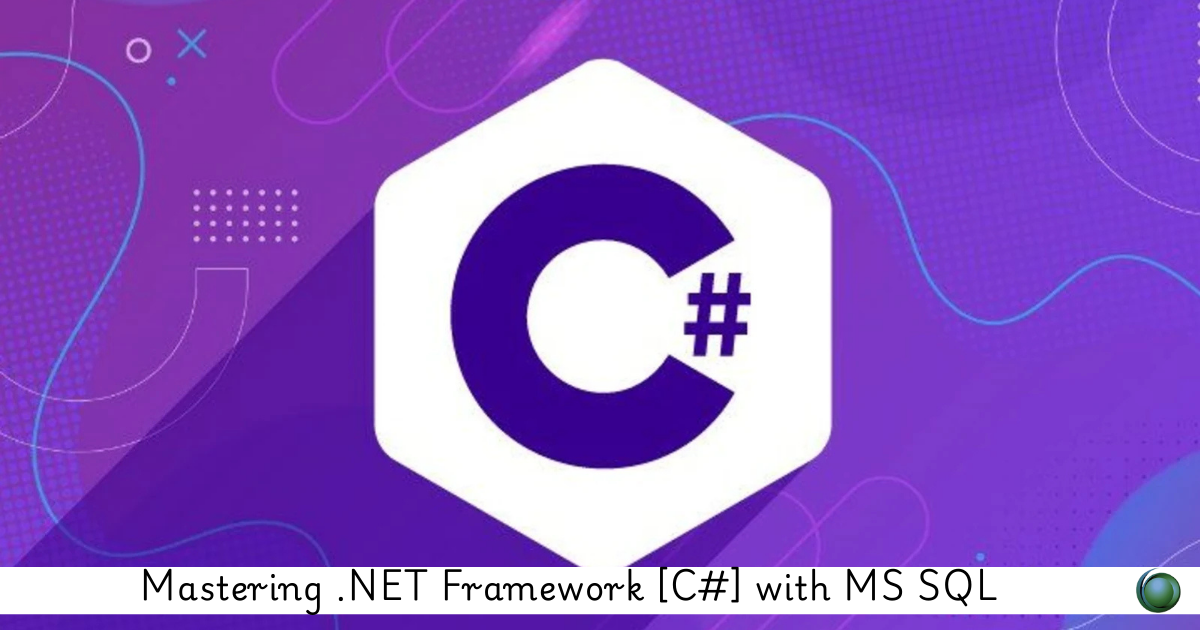Description
Introduction
The .NET Framework, coupled with C# and MS SQL, is a powerful combination for building robust, scalable applications. C# provides a modern, object-oriented programming language with features that streamline development for Windows-based applications. MS SQL Server complements this by offering a reliable and efficient database management system for storing and managing data. Together, they create a comprehensive development environment suited for enterprise-level applications, web solutions, and data-driven projects.
Prerequisites for .NET Framework (C#) with MS SQL
- Basic Programming Knowledge: Familiarity with programming concepts, ideally in an object-oriented language.
- Understanding of C# Syntax: Knowledge of C# fundamentals, including variables, functions, control structures, and classes.
- SQL Basics: Experience with SQL syntax, database queries, and data manipulation.
- Database Fundamentals: Basic knowledge of relational database concepts, indexing, and data relationships.
- Development Environment Setup: Familiarity with Visual Studio or similar IDEs for .NET development.
TABLE OF CONTENT
1. Introduction to .NET Framework
1.1 Overview of .NET Framework
1.2 Common Language Runtime (CLR)
1.3 Common Type System (CTS)
1.4 .NET Framework Class Library
2. C# Programming Basics
2.1 Data Types and Variables
2.2 Control Flow (if Statements, Loops)
2.3 Functions and Methods
2.4 Object-Oriented Programming Concepts
3. Advanced C# Programming
3.1 Exception Handling(Ref: Integrating Discrete ERP with Other Enterprise Solutions)
3.2 Delegates and Events
3.3 LINQ (Language Integrated Query)
3.4 Asynchronous Programming with async/await
4. Introduction to MS SQL Server
4.1 Overview of Relational Databases
4.2 SQL Server Architecture
4.3 Creating Databases and Tables
4.4 SQL Queries and Data Manipulation(Ref: MS SQL Administration)
5. Connecting C# with MS SQL Server
5.1 ADO.NET Basics
5.2 SqlConnection and SqlCommand
5.3 DataReader and DataSet
5.4 Parameterized Queries
6. Entity Framework
6.1 Introduction to Entity Framework
6.2 Code-First and Database-First Approaches
6.3 CRUD Operations with Entity Framework
6.4 LINQ to Entities
7. ASP.NET for Web Development
7.1 Introduction to ASP.NET
7.2 WebForms vs. MVC
7.3 Creating Web Applications
7.4 Working with Controls and Views
8. ASP.NET Core
8.1 Overview of ASP.NET Core
8.2 Building RESTful APIs
8.3 Dependency Injection in ASP.NET Core
8.4 Middleware and Pipeline
9. Authentication and Authorization
9.1 Forms Authentication
9.2 Windows Authentication
9.3 Role-Based Authorization
9.4 Claims-Based Authentication
10. Deployment and Security
10.1 Deploying .NET Applications
10.2 Securing ASP.NET Applications
10.3 Best Practices for Application Security
Conclusion
Combining .NET Framework with C# and MS SQL provides developers with a solid foundation to create data-driven applications that are both scalable and secure. This integration streamlines the development of enterprise solutions, leveraging the strengths of both C# for application logic and MS SQL for data management. With strong language support, extensive libraries, and a well-defined architecture, this stack offers a robust framework for building efficient, high-performance applications tailored to complex business needs.







Reviews
There are no reviews yet.